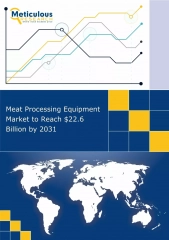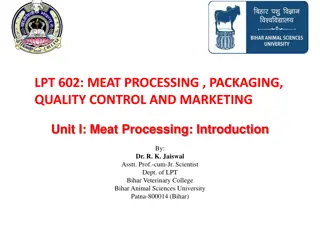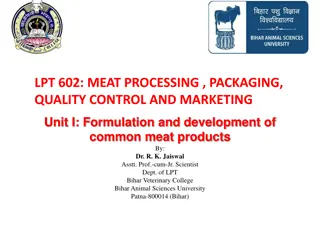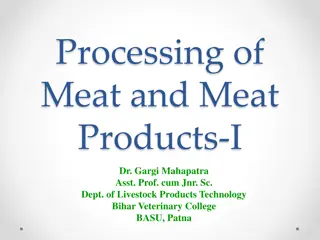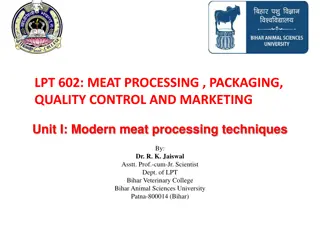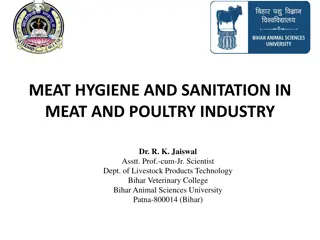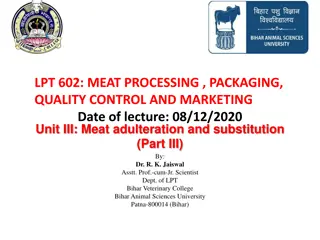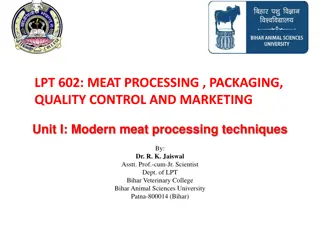Meat Substitution Fraud and Detection Methods
Fraudulent substitution of meat involves replacing quality meat with inferior or unconventional sources. Detection methods include physical, chemical, serological, and molecular examinations, utilizing techniques based on color, texture, odors, and anatomical characteristics to ensure meat authenticity.
Download Presentation

Please find below an Image/Link to download the presentation.
The content on the website is provided AS IS for your information and personal use only. It may not be sold, licensed, or shared on other websites without obtaining consent from the author.If you encounter any issues during the download, it is possible that the publisher has removed the file from their server.
You are allowed to download the files provided on this website for personal or commercial use, subject to the condition that they are used lawfully. All files are the property of their respective owners.
The content on the website is provided AS IS for your information and personal use only. It may not be sold, licensed, or shared on other websites without obtaining consent from the author.
E N D
Presentation Transcript
COURSE TITLE- MEAT SCIENCE COURSE NO.- LPT-321 (6thSEMESTER) Dr. SUSHMA KUMARI DEPT. OF LPT BVC, PATNA BIHAR ANIMAL SCIENCES UNIVERSITY
Fraudulent substitution of Meat Replacement of conventional meat by similar looking inferior quality or non-conventional sources is known as fraudulent substitution of meat or falsification of meat. It may include Mixing meat of different animals Mixing or replacement of inferior/undesirable meat with superior/costly meat. Eg. beef with horse flesh Mutton with chevon Rabbit meat with cat flesh etc.
Methods of Detection of Meat Falsification 1 Physical Examination 2 Chemical Examination 3 Serological Examination 4 Molecular Examination
Physical techniques: on the basis of Colour Texture Odour Presence of other body parts along with meat
GOAT MEAT SHEEP MEAT BEEF PORK
Anatomical techniques: The typical dental formulations Identification is on the basis of vertebrae Ribs number present on the carcass. Histological techniques: Muscle fiber length Diameter Density Pattern of the muscle fibers
2. Chemical Examination Determination of fat in meat Determination of ash in edible bone meal
3.Serological/Biological Examination: Also Immunological methods. Precipitation test Chromatography Electrophoresis known as Serological or
4. Molecular Examination DNA based molecular techniques: 1. PCR based 2. Non PCR based
Species Identification by using PCR Based Techniques Forensically informative nucleotide sequencing (FINS), a technique that combines DNA sequencing and phylogenetic analysis. It is used to identify samples based on informative nucleotide sequences. PCR amplification and sequencing of conserved gene is one of the first techniques for meat spp.identification. Mitochondrial DNA is highly conserved, gene on it Cytochrome-b and 12S-r RNA used for meat spp.identification.
Advantages of PCR based Techniques- We can be detected the wide variety meat samples. Fresh or processed meat can be easily detected. Much reliable. Very small amount of adulteration (up to 1%) can be easily identified.
Non PCR Based Techniques Species identification by hybridization Dot-blots hybridization technique has been applied to the detection of species-specific DNA fragments in the cooked meats of chicken, pig, goat, sheep, and beef. The probes, biotin-labeled chromosomal DNA fragments, were hybridized to the sample DNA on nylon membranes.
Advantages- Simple and quick Easy to perform Can be perform everywhere Disadvantages Costly Heat sensitive Species specific probe is required



